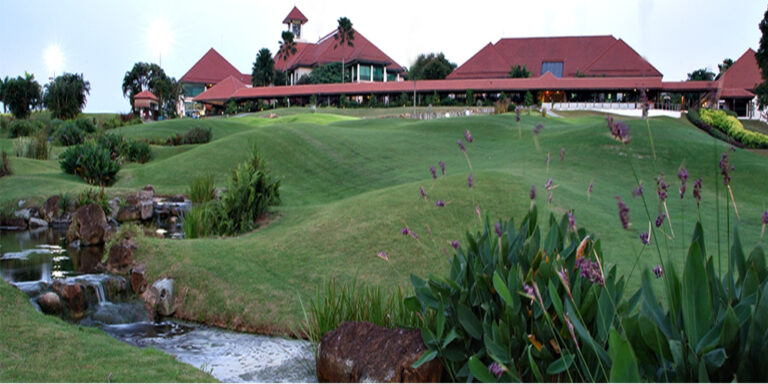Sweeping, $20 million renovation to begin this summer
SINGAPORE (July 18, 2018) — Seletar Country Club has selected Golfplan to direct a sweeping, $20 million renovation to begin this summer — no surprise, as few if any course architecture firms better understand the physical and market terrain here the highly regulated island nation.
Led by partners Kevin Ramsey and David Dale, Golfplan (www.golfplan.com) are the original designers at Singapore’s top track: The Serapong Course at Sentosa Golf Club. The firm has also led separate renovation efforts at the nation’s largest golf property, Singapore Island Country Club.
“It was a competitive design competition for the Seletar job — a dozen different firms put in for it,” Ramsey says. “I’m sure that we were chosen in part because we are so familiar with the unique parameters of course design work here. I can’t imagine anyone is more comfortable with the baroque government regulation process — we’ve been through it so many times.
“But ultimately, we got the job because our design solutions were the most artful and efficient. We can’t wait to get started.”
Built in 1991, Seletar CC sits quite some distance from Singapore’s central business district, high in the island’s interior near Seletar Airport and directly beside the Seletar Reservoir. All golf courses in Singapore exist at the pleasure of the government, on leased property. In 2017, authorities announced that they would reclaim a 5-hectare strip of land along the reservoir to make way for new hiking and bike paths.
Reclamation of this 15-meter wide swath directly impacts six existing holes at Seletar CC. Moving and/or rerouting those six will, according to Ramsey, affect another five holes.
“It’s a domino effect,” the architect explains. “With safety setbacks, the six holes along the reservoir have been completely redesigned, which necessitated the rerouting and redesign of five additional holes. Making everything fit together — in an aesthetic sense, in the golfing sense, in the safety sense — required a great deal of ingenuity on our part. We still have fully 160 acres [64 hectares] at our disposal, but this will will be a brand new 18 and a vastly improved one when we’re finished.
“The original course is nearly 30 years old and has never undergone serious renovation. With 11 holes being totally reimagined and reconstructed, the club wisely saw the opportunity to sand-cap the entire course footprint, lay new irrigation, rebuild all the bunkers, and regrass with Zeon zoysia.”
Formed in 1972, Golfplan is the most international design group in all of golf, creating more than 217 original designs in 32 different countries (if renovation and master planning is considered, make that 85 countries). This sort of sustained, diverse productivity is one reason GolfInc magazine named Dale and Ramsey among the “Top 10 Most Powerful People in Asian Golf” for 2016.
As large urban centers like Singapore continue to expand and develop, often it is the golf course stock that is obliged to make way. This has always been the case in Singapore, where all the courses exist on government-owned land. It is also the case in Jakarta, where Ramsey recently finished remodeling the fourth, fifth and sixth holes at celebrated Cenkareng Golf Club — to accommodate expansion of the nearby airport.
“I give the Board at Seletar a lot of credit for seizing the moment here,” says Ramsey, who anticipates a grand reopening in the fall of 2019. “Something had to be done to address the land reclamation, but they’re doubling down on the opportunity — spending 20 million Sing dollars to create an entirely new course, one that will compete very well in this market going forward.”
Dale concurs: “We can agree Sentosa, which our firm designed in the 1980s, is clearly the no. 1 club on the island (Golf Digest recently ranked it No. 79 in the world. Singapore Island always has grand plans but nothing substantial ever seems to get done. And Tanah Merah’s new course — recently renovated to accommodate another airport expansion — has not been particularly well received. I think Seletar has a real chance here to use this make-over to acquire significant market share.”
Seletar has always been among the most difficult and unique course designs in all of Southeast Asia. The original designer, Chris Pittman (a Golfplan associate prior to starting his own firm in the late 1980s), outfitted the 18 here with a series of pot bunkers, many of truly devilish depth and dimension. The club wants these signature elements preserved, so Golfplan will rebuild them in what Ramsey calls “the Royal St. George” style, complete with flat sand bottoms and steep grass faces.
“The club is very much attached to this bunker style and the challenge it presents,” he says. “From an architectural standpoint, our goal is to open up the views into these bunkers — to show the golfer more sand — so they don’t look like a succession of big, bottomless pits. We’ve also designed the new ones with zero-minimum leading edges, meaning the steep faces remain but they are much easier to walk in and out of. This will improve aesthetics and maintainability, while preserving the challenge.”
The renovation includes three more major components: rebuilding all 18 greens (and regrassing them with paspalum or TifEagle); the regrading of several fairways, which up to now had been crowned and kicked many fine shots out of play; and the enlargement/deepening of each and every water hazard at Seletar.
Dale notes that all Singaporean golf courses are now required by law to be 100 percent water self-sufficient. Rainfall is more than plentiful here but there is a dry season, too. The Golfplan renovation plan calls for the de-silting and enlargement of all existing water features — to create the water-storage capacity Seletar needs and sustain turfgrass quality year around.
“I think the Seletar Reservoir sits at 101.5 meters above sea level, and all our lakes are situated above that — so there are no water table issues here, unlike many Sing clubs that sit at or near sea level,” Dale explains. “The clubhouse here sits up at 120, or 20 meters above the reservoir — so it has stunning views out over the course and reservoir below. With all the moving parts inherent to this renovation, we’ve worked very hard to preserve the site’s many mature trees. It’s such a gorgeous setting. Our whole approach was centered around preserving those vistas while enhancing the strategic challenge of play. Improved visibility is a big factor at Seletar.”
Santa Rosa, California-based Golfplan is busy around the world in 2018:
• Chee Chan Golf Resort (www.cheechangolf.com), an original 18-hole design from partner David Dale, debuted in May in the significant shadow of the Chee Chan Buddha, near Pattaya, Thailand.
• Dale has three more original 18s now under construction in South Korea, where he’s also tweaking The Club at Nine Bridges (world no. 23 in the same Golf Digest ranking) for the U.S. PGA Tour’s CJ Cup in October.
• The back nine at Ramsey-designed Samsun Golf Club, located on Turkey’s Black Sea coast, is now open for play. Some 500 miles to the east, in the former Soviet Republic of Georgia, his 9-hole Tabori Hill project has entered the final grassing. It is scheduled to open late in 2018.
• In Kenya, Ramsey has finished the second 9 at Lake Victoria CC, where the full 18 will also debut this fall.
For more information on these and other Golfplan projects, visit www.golfplan.com.


